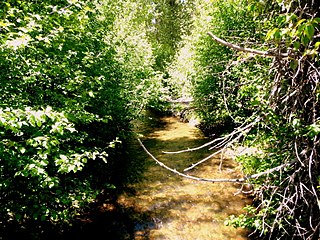The Forestry Commission is a non-ministerial government department responsible for forestry in England and Scotland. It was set up in 1919 to expand Britain's forests and woodland after depletion during the First World War. To do this, the commission bought large amounts of former agricultural land, eventually becoming the largest land owner in Britain. The Commission is divided into three divisions: Forestry Commission England, Forestry Commission Scotland and Forest Research. Forestry Commission Scotland reports to the Scottish Government.
A tree farm is a privately owned forest managed for timber production. The term, tree farm, also is used to refer to tree plantations, tree nurseries, and Christmas tree farms.

A forester is a person who practices forestry, the science, art, and profession of managing forests. Foresters engage in a broad range of activities including ecological restoration and management of protected areas. Foresters manage forests to provide a variety of objectives including direct extraction of raw material, outdoor recreation, conservation, hunting and aesthetics. Emerging management practices include managing forestlands for biodiversity, carbon sequestration and air quality.

Forestry laws govern activities in designated forest lands, most commonly with respect to forest management and timber harvesting. Ancillary laws may regulate forest land acquisition and prescribed burn practices. Forest management laws generally adopt management policies, such as multiple use and sustained yield, by which public forest resources are to be managed. Governmental agencies are generally responsible for planning and implementing forestry laws on public forest lands, and may be involved in forest inventory, planning, and conservation, and oversight of timber sales. Broader initiatives may seek to slow or reverse deforestation.

The Minnesota Department of Natural Resources is the agency of the U.S. state of Minnesota charged with conserving and managing the state's natural resources. The agency maintains areas such as state parks, state forests, recreational trails, and recreation areas as well as managing minerals, wildlife, and forestry throughout the state. The agency is divided into six divisions - Ecological & Water Resources, Enforcement, Fish & Wildlife, Forestry, Lands & Minerals, and Parks & Trails.

The Michigan Department of Natural Resources (DNR) is the agency of the state of Michigan charged with maintaining natural resources such as state parks, state forests, and recreation areas. It is governed by a director appointed by the Governor and accepted by the Natural Resources Commission. Currently the Director is Keith Creagh. The DNR has about 1,400 permanent employees, and over 1,600 seasonal employees.

In the state of New Jersey, the New Jersey Division of Parks and Forestry is an administrative division of the New Jersey Department of Environmental Protection. In its most visible role, the Division is directly responsible for the management and operation of New Jersey's public park system which includes 42 state parks, 11 state forests, 3 recreation areas, and more than 50 historic sites and districts. However, its duties also include protecting state and private lands from wildfire, managing forests, educating the public about environmental stewardship and natural resources, as well as growing trees to maintain and restore forests in rural and urban areas, and to preserve the diversity of the trees within the forests.
The following outline is provided as an overview of and guide to forestry:
The Hawaiʻi Department of Land and Natural Resources (DLNR) is a part of the Hawaiʻi state government dedicated to managing, administering, and excerising control over public lands, water resources and streams, ocean waters, coastal areas, minerals, and other natural resources of the state of Hawaiʻi. The mission of the Hawaiʻi Department of Land and Natural Resources is to "enhance, protect, conserve and manage Hawaiʻi's unique and limited natural, cultural and historic resources held in public trust for current and future generations of the people of Hawaiʻi nei, and its visitors, in partnership with others from the public and private sectors." The organization oversees over 1.3 million acres of land, beaches, and coastal waters and 750 miles of coastal land.
The Maryland Forest Service in 1996 marked the 90th anniversary of forestry in Maryland, United States and the birth of what is known as the Department of Natural Resources Forest Service. Although the service has been known by many names over nine decades, its mission has been consistent: "To conserve and enhance the quality, quantity, productivity and biological diversity of the forest and tree resources of Maryland."

Sun Pass State Forest is one of six state forests managed by the Oregon Department of Forestry. The forest is located 40 miles (64 km) north of Klamath Falls, Oregon near the southeastern corner of Crater Lake National Park. It is the largest single block of Oregon state forestry land east of the Cascade Mountains. The forest is managed as part of the Klamath-Lake District, comprising 21,317 acres (86.27 km2) of the 33,739 state-owned acres within the district.

The Oregon Board of Forestry is responsible for forest policy and oversight of forest management practices within the state of Oregon. The board appoints the state forester and oversees the Oregon Department of Forestry. The board also works with private land owners and the Federal Government to promote consistent forest management policies throughout the state.
The Virginia Department of Forestry (VDOF) was established in 1914 to prevent and suppress forest fires and reforest bare lands. Since its inception, the agency has grown and evolved to encompass other protection and management duties:
Forest genetic resources or tree genetic resources are genetic material of shrub and tree species of actual or future value. Forest genetic resources are essential for forest-depending communities who rely for a substantial part of their livelihoods on timber and non-timber forest products for food security, domestic use and income generation. These resources are also the basis for large-scale wood production in planted forests to satisfy the worldwide need for timber and paper. Genetic resources of several important timber, fruit and other non-timber tree species are conserved ex situ in genebanks or maintained in field collections. Nevertheless, in situ conservation in forests and on farms is in the case of most tree species the most important measure to protect their genetic resources.

The Oklahoma Conservation Commission is an agency of the government of Oklahoma under the Governor of Oklahoma. It is the duty of the Commission to conserve Oklahoma's land and water. The Commission is also responsible for upstream flood control protection, a state-funded conservation cost-share program, reclamation of abandoned mine land and non point source water quality monitoring, planning, and management, in addition to a variety of educational and informational activities.

The Tamil Nadu Forest Department was established as the Madras Forest Department in 1855 by Dr Hugh Francis Cleghorn, "the father of scientific forestry in India". The department is responsible for managing all the protected areas and forests plus environmental and wildlife related issues of Tamil Nadu state in South India. The objective of the Tamil Nadu Forest Department is to conserve biodiversity and eco-systems of forests and wilderness areas to ensure water security and food security of the state.
The North Carolina Forest Service, formerly known as the North Carolina Division of Forest Resources is a North Carolina state government agency responsible for providing land management assistance to landowners. The agencies priority responsibility is for wildland fire control on all state and privately owned land in North Carolina, United States. The Service was a Division of the N.C. Department of Environment and Natural Resources until July 2011 and is now part of the North Carolina Department of Agriculture and Consumer Services.
Forest conservation is the practice of planning and maintaining forested areas for the benefit and sustainability of future generations.Forest conservation involves the upkeep of the natural resources within a forest that are beneficial to both humans and the ecosystem. Forest conservation acts to maintain, plan, and improve forested areas. Forests provide wildlife with a suitable habitat for living along with filtering groundwater and preventing runoff.

The Mississippi Forestry Commission (MFC) is a State Agency in Mississippi with headquarters in Jackson. The Forestry Commission was authorized "to prevent, control, and extinguish forest fires; enforce laws pertaining to the protection of forests and woodlands in the state; and encourage forest and tree planting for the production of a wood crop and other beneficial purposes". The agency was created in 1926.













